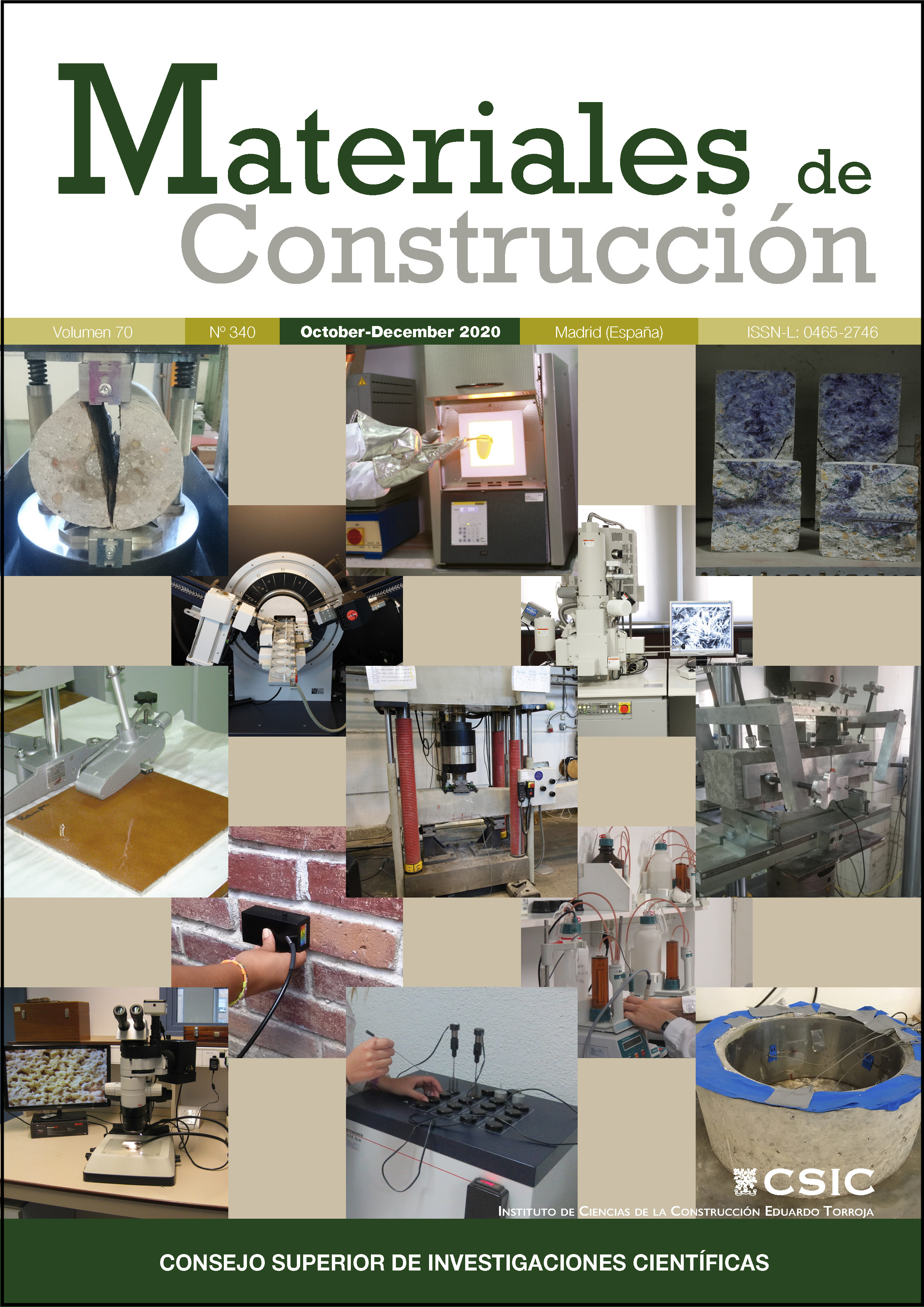Effect of different high surface area silicas on the rheology of cement paste
DOI:
https://doi.org/10.3989/mc.2020.15719Keywords:
Rheology, Workability, Superficial area, Pozzolan, Cement pasteAbstract
This work studies the effect of nanosilica (NS) on the rheology of cement paste by comparing it with two high specific surface area silicas: silica fume (SF) and pyrogenic silica (PS). Portland cement pastes were produced with different water-to-cementing material ratios and different solid substitutions of cement by silica. Water demand, setting time, and rheology tests were performed. Results showed that NS and SF decreased plastic viscosity, while PS increased it. Only PS was found to have an effect on yield stress. NS showed the most decreasing effect on viscosity, regardless of its higher water demand. It was concluded that the behavior of pastes containing NS and SF is governed by the “ball-bearing” effect from silica particles, by their agglomeration degree, and their impact on the solid volume fraction. The behavior of pastes containing PS is governed by its ability to absorb a portion of the mixing water.
Downloads
References
Kwan, A.K.H.; Li, Y. (2013) Effects of fly ash microsphere on rheology, adhesiveness and strength of mortar. Constr. Build. Mater. 42, 137-145. https://doi.org/10.1016/j.conbuildmat.2013.01.015
Jal, P.K.; Sudarshan, M.; Saha, A.; Patel, S.; Mishra, B.K. (2004) Synthesis and characterization of nanosilica prepared by precipitation method. Coll. Surf. A Physicochem. Eng. Asp. 240 [1-3], 173-178. https://doi.org/10.1016/j.colsurfa.2004.03.021
El Sokkary, T. M.; Assal, H. H.; Kandeel, A. M. (2004) Effect of silica fume or granulated slag on sulphate attack of ordinary portland and alumina cement blend. Ceram. Int. 30 [2], 133-138. https://doi.org/10.1016/S0272-8842(03)00025-7
Gutsch, A.; Krämer, M.; Michael, G.; Mühlenweg, H.; Pridöhl, M.; Zimmermann, G. (2002) Gas-Phase production of nanoparticles. KONA Powder Part. J. 20, 24-37. https://doi.org/10.14356/kona.2002008
Singh, L.P.; Karade, S.R.; Bhattacharyya, S.K.; Yousuf, M.M.; Ahalawat, S. (2013) Beneficial role of nanosilica in cement based materials - A review. Constr. Build. Mater. 47, 1069-1077. https://doi.org/10.1016/j.conbuildmat.2013.05.052
Björnström, J.; Martinelli, A.; Börjesson, L.; Panas, I.; (2004) Accelerating effects of colloidal nano-silica for beneficial calcium-silicate-hydrate formation in cement. Chem. Phys. Lett. 392 [1-3], 242-248. https://doi.org/10.1016/j.cplett.2004.05.071
Mendoza Reales, O.A.; Silva, E.C.C.M.; Paiva, M.D.M.; M.; Duda, P.; Toledo Filho, R.D. (2017) The role of surface area and compacity of nanoparticles on the rheology of cement paste 25.3. ACI Symp. Pub. 320, 25.1-25.14. https://www.concrete.org/publications/internationalconcreteabstractsportal/m/details/id/51701063.
Tobón, J. I.; Mendoza Reales, O.; Retrepo, O.J.; Borrachero, M.V. (2018) Effect of pyrogenic silica and nanosilica on Portland cement matrices. J. Mater. Civ. Eng. 30 [10], 1-10. https://doi.org/10.1061/(ASCE)MT.1943-5533.0002482
Mehdipour, I.; Khayat, K.H. (2018) Understanding the role of particle packing characteristics in rheo-physical properties of cementitious suspensions: A literature review. Constr. Build. Mater. 161, 340-353. https://doi.org/10.1016/j.conbuildmat.2017.11.147
Boukendakdji, O.; Kadri, E.H.; Kenai, S. (2012) Effects of granulated blast furnace slag and superplasticizer type on the fresh properties and compressive strength of selfcompacting concrete. Cem. Concr. Compos. 34 [4], 583-590. https://doi.org/10.1016/j.cemconcomp.2011.08.013
Park, C.K.; Noh, M.H.; Park, T.H. (2005) Rheological properties of cementitious materials containing mineral admixtures. Cem. Concr. Res. 35 [5], 842-849. https://doi.org/10.1016/j.cemconres.2004.11.002
Deng, H.; Li, H. (2018) Assessment of self-sensing capability of carbon black engineered cementitious composites. Constr. Build. Mater. 173, 1-9. https://doi.org/10.1016/j.conbuildmat.2018.04.031
Mendoza-Reales, O.A.; Arias Jaramillo, Y.P.; Ochoa Botero, J.C.; Delgado, C.A.; Quintero, J.H.; Toledo Filho, R.D. (2018) Influence of MWCNT/surfactant dispersions on the rheology of Portland cement pastes. Cem. Concr. Res. 107, 101-109. https://doi.org/10.1016/j.cemconres.2018.02.020
Quercia, G.; Hüsken, G.; Brouwers, H.J.H. (2012) Water demand of amorphous nano silica and its impact on the workability of cement paste. Cem. Concr. Res. 42 [2], 344-357. https://doi.org/10.1016/j.cemconres.2011.10.008
Norhasri, M.S.M.; Hamidah, M.S.; Fadzil, A.M. (2017) Applications of using nano material in concrete: A review. Constr. Build. Mater. 133, 91-97. https://doi.org/10.1016/j.conbuildmat.2016.12.005
Bowen, P. (2002). Particle size distribution measurement from millimeters to nanometers and from rods to platelets. J. Dispers. Sci. Technol. 23 [5], 631-662. https://doi.org/10.1081/DIS-120015368
Staiger, M.; Bowen, P.; Ketterer, J.; Bohonek, J. (2002) Particle size distribution measurement and assessment of agglomeration of commercial nanosized ceramic particles. J. Dispers. Sci. Technol. 23 [5], 619-630. https://doi.org/10.1081/DIS-120015367
Hidalgo, A.; Petit, S.; Domingo, C.; Alonso, C.; Andrade, C. (2007) Microstructural characterization of leaching effects in cement pastes due to neutralisation of their alkaline nature. Part I: Portland cement pastes. Cem. Concr. Res. 37 [1], 63-70. https://doi.org/10.1016/j.cemconres.2006.10.002
Srinivasan, S.; Barbhuiya, S.A.; Charan, D.; Pandey, S.P. (2010) Characterising cement-superplasticiser interaction using zeta potential measurements. Constr. Build. Mater. 24 [12], 2517-2521. https://doi.org/10.1016/j.conbuildmat.2010.06.005
de Larrard, F. (1999) Concrete mixture proportioning a scientific approach, E. & F.N. Spon, London. https://doi.org/10.1201/9781482272055
Banfill, P.F.G. (2006) Rheology of fresh cement and concrete. Rheol. Reviews 2006. 61-130.
Burneau, A.; Barres, O.; Gallas, J.P.; Lavalley, J.C. (1990) Comparative Study of the Surface Hydroxyl Groups of Fumed and Precipitated Silicas. 2. Chatracterization by infrared spectroscopy of the interacctions with water. Langmuir. 6 [8], 1364-1372. https://doi.org/10.1021/la00098a008
Xie, X-L.; Liu, Q-X.; Li, R.K-Y.; Zhou, X-P.; Zhang, Q-X.; Yu, Z-Z.; Mai, Y-W. (2004) Rheological and mechanical properties of PVC/CaCO3 nanocomposites prepared by in situ polymerization. Polymer. 45 [19], 6665-6673. https://doi.org/10.1016/j.polymer.2004.07.045
Asavapisit, S.; Fowler, G.; Cheeseman, C.R. (1997) Solution chemistry during cement hydration in the presence of metal hydroxide wastes. Cem. Concr. Res. 27 [8], 1249-1260. https://doi.org/10.1016/S0008-8846(97)00109-9
Published
How to Cite
Issue
Section
License
Copyright (c) 2020 Consejo Superior de Investigaciones Científicas (CSIC)

This work is licensed under a Creative Commons Attribution 4.0 International License.
© CSIC. Manuscripts published in both the print and online versions of this journal are the property of the Consejo Superior de Investigaciones Científicas, and quoting this source is a requirement for any partial or full reproduction.
All contents of this electronic edition, except where otherwise noted, are distributed under a Creative Commons Attribution 4.0 International (CC BY 4.0) licence. You may read the basic information and the legal text of the licence. The indication of the CC BY 4.0 licence must be expressly stated in this way when necessary.
Self-archiving in repositories, personal webpages or similar, of any version other than the final version of the work produced by the publisher, is not allowed.
















